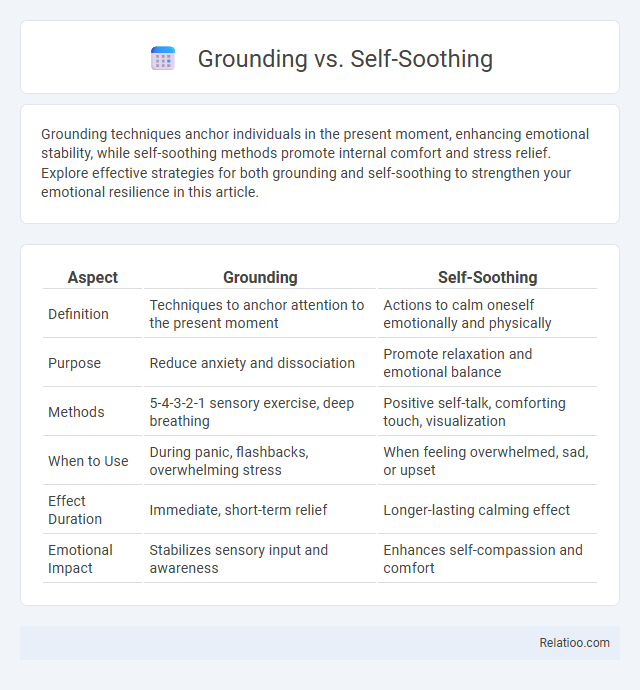Grounding techniques anchor individuals in the present moment, enhancing emotional stability, while self-soothing methods promote internal comfort and stress relief. Explore effective strategies for both grounding and self-soothing to strengthen your emotional resilience in this article.
Table of Comparison
| Aspect | Grounding | Self-Soothing |
|---|---|---|
| Definition | Techniques to anchor attention to the present moment | Actions to calm oneself emotionally and physically |
| Purpose | Reduce anxiety and dissociation | Promote relaxation and emotional balance |
| Methods | 5-4-3-2-1 sensory exercise, deep breathing | Positive self-talk, comforting touch, visualization |
| When to Use | During panic, flashbacks, overwhelming stress | When feeling overwhelmed, sad, or upset |
| Effect Duration | Immediate, short-term relief | Longer-lasting calming effect |
| Emotional Impact | Stabilizes sensory input and awareness | Enhances self-compassion and comfort |
Understanding Grounding and Self-Soothing
Understanding the differences between grounding and self-soothing techniques is essential for managing stress and emotional regulation effectively. Grounding focuses on reconnecting you to the present moment by engaging the five senses to overcome anxiety or dissociation, while self-soothing involves calming your mind and body through comforting actions or thoughts. Mastering both approaches enhances your ability to respond to emotional distress with clarity and resilience.
Key Differences Between Grounding and Self-Soothing
Grounding techniques focus on reconnecting with the present moment by using the five senses to reduce anxiety and dissociation, while self-soothing involves activities that calm the emotional state, such as gentle touch or comforting thoughts. Grounding is more cognitive and sensory-based, aiming to anchor the mind in reality, whereas self-soothing targets emotional regulation and comfort. Key differences include grounding's emphasis on external sensory input versus self-soothing's reliance on internal emotional comfort strategies.
The Science Behind Grounding Techniques
Grounding techniques activate your body's parasympathetic nervous system, reducing stress by redirecting attention to the present moment through sensory engagement, which contrasts with self-soothing methods that emphasize emotional regulation via comforting activities. Neuroscientific research shows grounding stimulates the brain's prefrontal cortex, enhancing cognitive control over anxiety and trauma responses. Understanding the distinct neural pathways involved in grounding versus self-soothing helps tailor effective therapeutic interventions for emotional resilience.
How Self-Soothing Influences Emotional Regulation
Self-soothing techniques activate the parasympathetic nervous system, promoting relaxation and reducing emotional distress. These strategies help individuals manage overwhelming feelings by calming the mind and body, which enhances overall emotional regulation. Grounding techniques complement this process by anchoring attention to the present moment, further stabilizing emotional responses.
When to Use Grounding Techniques
Grounding techniques are most effective during moments of acute anxiety, panic attacks, or dissociation when a quick return to present reality is crucial. Unlike self-soothing, which is ideal for managing longer-term emotional distress or chronic stress, grounding focuses on immediate sensory awareness to stabilize thoughts. Using grounding methods such as the 5-4-3-2-1 technique or deep breathing helps anchor individuals in the present, especially during sudden emotional overwhelm.
When Self-Soothing is Most Effective
Self-soothing is most effective during moments of acute emotional distress when immediate internal comfort is needed to regulate overwhelming feelings. Techniques such as deep breathing, positive self-talk, or engaging in comforting sensory experiences help activate the parasympathetic nervous system, promoting calmness and reducing stress hormones. This contrasts with grounding, which is often used to reconnect with the present moment and external reality during dissociation or flashbacks.
Common Grounding Exercises for Stress Relief
Common grounding exercises for stress relief include techniques like deep breathing, body scan meditation, and sensory awareness, which help anchor your focus in the present moment and reduce anxiety. Self-soothing methods, such as gentle touch or calming imagery, engage your senses to promote emotional comfort and relaxation. Practicing these grounding and self-soothing strategies regularly can enhance your ability to manage stress and maintain mental balance during challenging situations.
Popular Self-Soothing Strategies for Anxiety
Popular self-soothing strategies for anxiety include grounding techniques, which involve focusing on the present moment through sensory awareness, such as naming five things you can see or feel. Self-soothing often incorporates calming activities like deep breathing, progressive muscle relaxation, or engaging with comforting items like soft textures and warm beverages. Combining grounding with self-soothing can enhance overall emotional regulation by reducing distress and promoting a sense of safety during anxiety episodes.
Integrating Grounding and Self-Soothing in Daily Life
Integrating grounding and self-soothing techniques in daily life enhances emotional regulation and resilience by combining physical presence with calming practices. Grounding methods, such as mindful breathing or sensory focus, anchor awareness in the present moment, while self-soothing strategies, like gentle touch or positive affirmations, promote inner comfort and reduce stress. Together, these approaches create a balanced framework for managing anxiety and fostering mental well-being through consistent practice.
Choosing the Right Technique for Your Emotional Needs
Choosing the right technique for your emotional needs depends on whether you require immediate relief or long-term emotional regulation. Grounding focuses on connecting with the present moment through sensory awareness and external stimuli, ideal for managing acute anxiety or dissociation. Self-soothing, by contrast, involves nurturing activities and comfort to calm your internal emotional state, best suited for developing emotional resilience over time.

Infographic: Grounding vs Self-Soothing
 relatioo.com
relatioo.com